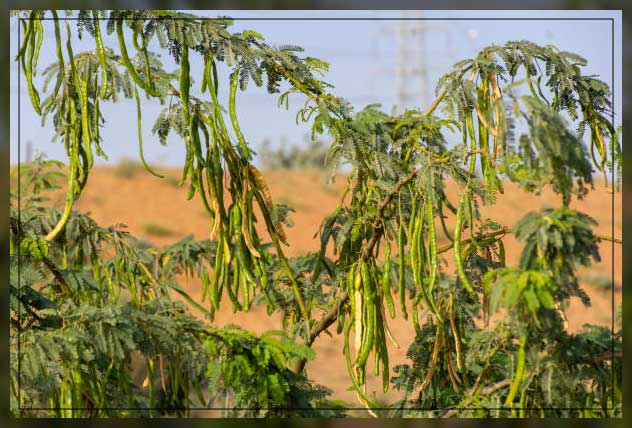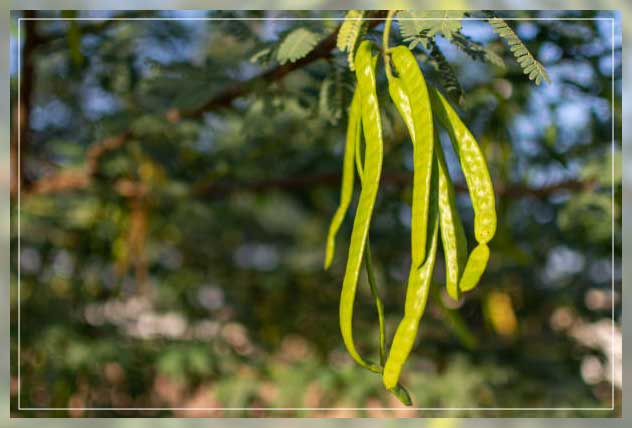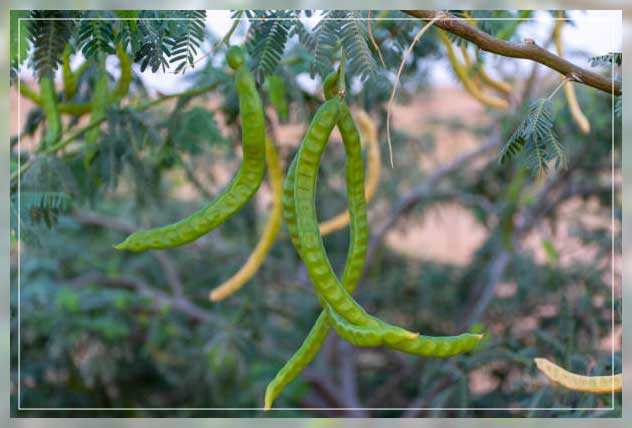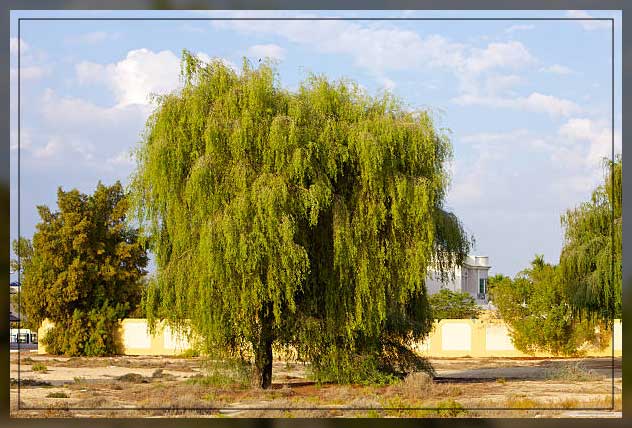How often do we pass by trees and fail to recognize them? Several of them form a distinctive layer of wood around their trunk annually as they age. These rings tell us about the rainfall, temperature, seasons and other information from that year. Effectively, the trees preserve the past. They allow us to record our ideas. We etch our marks on their bark and use their sheets to mark down our stories. Moreover, trees are poems which the earth writes upon the sky. Ghaf tree, or the Prosopis cineraria, is a species of flowering tree in the pea family, Fabaceae.

The tree is native to dry regions of Western Asia and the Indian subcontinent, including Afghanistan, Bahrain, India, Iran, Oman, Pakistan, Saudi Arabia, the United Arab Emirates, and Yemen. The Ghaf tree is the national tree of the UAE.
What is Ghaf Tree
Prosopis Cineraria, known as Jammi, Kandi, Shami, Khejri Tree, Jand, or Ghaf, is a species of flowering tree in the pea family, Fabaceae. The Ghaf tree is a medium to small-sized thorny tree with slender branches armed with conical thorns and with light bluish-green foliage. The leaflets are dark green with a thin casting of light shade. The tree is evergreen or nearly so. Just before summer, the tree produces new flush leaves.

The flowers are yellow or creamy white and are small in size. The flowers and then the seedpods appear from March to May after the new flush of leaves. After two months, the seedpods attain full maturity. Ghaf trees are deep-rooted as they get their water from the water table. The presence of the Ghaf tree indicates the presence of underground water. Its roots can get water from supplies as deep as 30 meters. Ghaf trees flower twice each year; March to May and October to January.
The Ghaf tree is well adapted to browsing by animals like goats and camels. Young Ghaf plants assume a cauliflower-like, bushy appearance in areas open to goat browsing. The Ghaf tree requires intense light, and dense shade will kill seedlings. The crown grows slowly. The root system of the Ghaf tree is long and well-developed. It secures a firm footing for the plant and allows it to obtain moisture from groundwater. Taproot penetration can go up to 35 m or 115 ft in soil depth. Like other members of the family Fabaceae, Symbiotic bacteria are found in its root nodules, thereby allowing it to fix nitrogen in the soil. This improves soil fertility.
Ghaf Tree Essential for Heritage and Environment
The Ghaf tree has multiple beneficial uses, from combating desertification and improving soil fertility in arid regions to being an essential food source and a source of fuel, shelter, and medicine for humans and animal species. Many birds, such as Brown-necked ravens, Yellow-throated sparrows, Desert eagle owls, and Long-legged buzzards, build nests on the Ghaf trees.

Bedouins sought it for its seeds. Its leaves were used earlier instead of rice. The extended pods of the Ghaf tree provide food for animals, supplying milk, cheese, butter, and meat. The woodlands of Ghaf trees also support large populations of insects, providing food for birds, reptiles, and small mammals. In other words, the Ghaf tree forms an essential element in the food chain in the region. This evergreen and sturdy tree can withstand prolonged drought and high salinity, tapping water deep in the sands.
The seedpods of the Ghaf tree contain a sweet pulp eaten by nearly all livestock and humans. The salads made from the Ghaf tree’s leaves are considered a delicacy in the UAE. Some other important uses include providing wood for construction and medicinal properties. It is recommended to treat chest congestion, toothaches, and even snakebites. Ghaf pods have been used as an ingredient in eye drops to cure cataracts. Additionally, the leaves are known to relieve toothache and indigestion. The sap is often used as an antiseptic.
Efforts Undertaken by UAE for Conserving Ghaf Tree
As per the UAE Federal Law No. 24 of 1999, cutting wild plants, uprooting, or illegally collecting them is prohibited. The government of UAE takes strict measures on any felling of local trees, especially for the Ghaf trees. The felling of the Ghaf tree has massive adverse effects on UAE’s natural biodiversity. Environmental Agency – Abu Dhabi’s plant nursery currently stores the seeds of 58 species of native wild plants, including the Ghaf tree.

In 2019, the government of UAE planted 600 Ghaf trees in the Al Faya Region, providing habitat and shelter for several thousand species, some of which are considered endangered globally. Moreover, the Ghaf trees serve as natural windbreakers for active winds in the region. Additionally, in 2019, the Ghaf Tree was selected as a symbol for the Year of Tolerance. Moreover, the government did this to acknowledge its role as a historical and cultural symbol of stability and peace in the desert environment of the UAE.
Ghaf Tree – Tree of Life
There exists a 400-year-old Ghaf tree, known as the ‘Tree of Life’ in Bahrain, which is still growing in the desert region without any obvious water sources. The tree stands on the top of a sandy hill in the Arabian Desert, miles from any other tree and with no apparent water source. It is a notable tourist attraction, drawing thousands of visitors every year. Earlier in 2008, the Ghaf tree was declared the national tree of the UAE.
On average, Ghaf trees can live for up to 120 years. Traditionally, Ghaf leaves and pods provided food, and people used their nutritious branches for livestock. Additionally, the tree was also usually used for its medicinal properties. The shades of Ghaf tree also serve as a meeting point for community gatherings. Under its branches, the UAE’s tribal leaders held important meetings and listened to and consulted with their citizens.

During famines, its pods provided nourishment, and its bark was grounded into flour to make cakes. Its slightly bitter leaves continue to be finely chopped in salads and crumbled over salted fish and rice. It provided shade and shelter in the hot summer. Its reddish-brown wood provided material for building houses, furniture, and livestock barns, while also serving as excellent firewood.
Ghaf Tree – Threats and Conservation
The number of Ghaf trees has reduced due to overgrazing, urban expansion, and reduced groundwater supplies. Moreover, mesquite trees (Prosopis juliflora) compete with them and suffocate the Ghaf trees. In the 1970s, this American species was introduced to the UAE to prevent desertification. The destruction wrought is a perfect example of the dangers of invasive species. However, the Ghaf tree is under threat due to global warming and the overgrazing of camels.
UAE’s population boom has led to overuse of groundwater. Consequently, this has resulted in dropping water tables beyond the reach of the tree roots. Additionally, the pollution of both air and water is also contributing to a decline in the number of trees in the UAE.
Ghaf tree has several uses, including as a critical element of agroforestry systems in semi-arid and arid regions. In agroforestry, trees are managed together with livestock and crops. Consequently, it helps to increase economic, social, and environmental benefits for farmers and other land users.
Several conservation initiatives have been launched in the UAE in response to these threats. This was done to secure the future of the Ghaf tree. One of the most notable was the Give a Ghaf tree planting scheme. It was established in 2011 by a social enterprise based in the UAE. This organization promotes sustainable living. By July 2020, almost 100,000 Ghaf trees had been planted by individuals, companies, schools, and organizations. Additionally, Ghaf trees are protected in the UAE. Cutting or damaging them is against the law and is punishable by a fine.
Ghaf Tree in UAE Wildlife Campaign
Emirates Nature and the WWF started a campaign in 2007, called Save the Ghaf Tree to make the endangered tree a national icon and raise awareness among UAE people. Emirates Nature and Emirates Wildlife Society were formerly known as the Wildlife Emirate. The campaign was well-received and a great success, with nearly 1,000 trees planted, and the Ghaf proclaimed the national tree the following year. Efforts to take care of this precious tree have been ongoing, and you can help the Ghaf.
Final Thoughts
The Ghaf tree holds great promise for improving soil fertility and combating desertification in arid environments thanks to its unique qualities. Considered the UAE’s national tree, Ghaf has several uses, including as a critical element of agroforestry systems in semi-arid and arid regions. Moreover, trees are managed together with livestock and crops in agroforestry. This helps to increase economic, social, and environmental benefits for farmers and other land users.
This tree helps in the reclamation of areas that were lost to desertification. The tree is highly salt-tolerant. Consequently, you can grow it in salt-affected soils or the marginal soils of the UAE and other countries of the Middle East. As a result, the deep and broad root system of the tree allows it to grow in extremely harsh conditions and help fight desertification.
The UAE is a multicultural society with more than 200 nationalities growing in harmonious co-existence. Just as a Ghaf tree stands resolute and tall while serving diverse desert ecosystems, so too the UAE hosts diversity while preserving its deeply rooted tradition and customs.
Read other articles on topics like trees in UAE, flowers UAE, flowering plants, non flowering plants, pollen grains, and more.






Leave a Reply